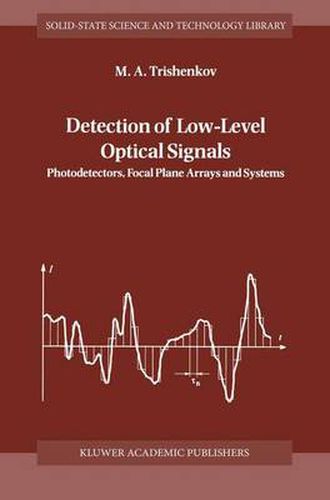Readings Newsletter
Become a Readings Member to make your shopping experience even easier.
Sign in or sign up for free!
You’re not far away from qualifying for FREE standard shipping within Australia
You’ve qualified for FREE standard shipping within Australia
The cart is loading…






This title is printed to order. This book may have been self-published. If so, we cannot guarantee the quality of the content. In the main most books will have gone through the editing process however some may not. We therefore suggest that you be aware of this before ordering this book. If in doubt check either the author or publisher’s details as we are unable to accept any returns unless they are faulty. Please contact us if you have any questions.
This work is aimed at designers of military and civil systems, such as systems for guiding and control, target acquisition, surveillance, laser range-finding, fiber-optical communications, thermal imaging and the like, as well as for designers of photodetectors for optical signal detection. The first question they face is how to detect an ultimately weak optical signal, for which this book aims to provide an answer. All the main types of photodetectors are considered, from photodiodes (including avalanche photodiodes) to focal plane arrays (FPA). Methods of matching photodetectors with preamplifiers are described. The pair photodetector plus preamplifier is treated as an integrated detection system. Attention is paid to different types of noise and ways of maximizing the signal-to-noise ratio (SNR). Foundations of theory of optimal filtering of photosignals are discussed taking due account of typical shapes of optical signals and noise spectra. Methods for tuning quasi-optimal filters to maximize the SNR are explained. The main problems associated with detection of low-level optical signals are considered: operation of avalanche photodiodes in photon count mode, filtering in the case of charge accumulation in FPA cells, and the effect of the number of pixels and geometry of FPAs on detection. Finally, using the examples of the laser range finder and IR Imager, guidelines for calculating the limiting parameters of optoelectronic systems to achieve the highest possible SNR are given.
$9.00 standard shipping within Australia
FREE standard shipping within Australia for orders over $100.00
Express & International shipping calculated at checkout
This title is printed to order. This book may have been self-published. If so, we cannot guarantee the quality of the content. In the main most books will have gone through the editing process however some may not. We therefore suggest that you be aware of this before ordering this book. If in doubt check either the author or publisher’s details as we are unable to accept any returns unless they are faulty. Please contact us if you have any questions.
This work is aimed at designers of military and civil systems, such as systems for guiding and control, target acquisition, surveillance, laser range-finding, fiber-optical communications, thermal imaging and the like, as well as for designers of photodetectors for optical signal detection. The first question they face is how to detect an ultimately weak optical signal, for which this book aims to provide an answer. All the main types of photodetectors are considered, from photodiodes (including avalanche photodiodes) to focal plane arrays (FPA). Methods of matching photodetectors with preamplifiers are described. The pair photodetector plus preamplifier is treated as an integrated detection system. Attention is paid to different types of noise and ways of maximizing the signal-to-noise ratio (SNR). Foundations of theory of optimal filtering of photosignals are discussed taking due account of typical shapes of optical signals and noise spectra. Methods for tuning quasi-optimal filters to maximize the SNR are explained. The main problems associated with detection of low-level optical signals are considered: operation of avalanche photodiodes in photon count mode, filtering in the case of charge accumulation in FPA cells, and the effect of the number of pixels and geometry of FPAs on detection. Finally, using the examples of the laser range finder and IR Imager, guidelines for calculating the limiting parameters of optoelectronic systems to achieve the highest possible SNR are given.